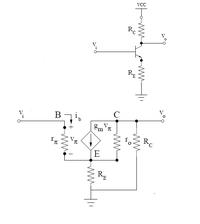jimito13
Advanced Member level 1
Dear forum members and experts,
I have a very basic question concerning the small-signal analysis of a common emitter amplifier with resistive emitter degeneration.I provide the circuit's schematic and it's small-signal equivalent at the attached image :

My question is :
At emitter node of the above ckt we can write kirchoff's law : ie=ib + (gm*uπ)+ir0.Up to here everything is clear to me.
We know that ie=ib+ic but now we have one more current term that is the ir0,thus the equation ie=ib+ic=ib+βib=(β+1)ib=>ie=(β+1)ib is no more valid.Am i right or am i making a mistake in my thoughts?
Thanks in advance for any helpful answer.
Best Regards,
Jimito13-Analog RFIC Designer
I have a very basic question concerning the small-signal analysis of a common emitter amplifier with resistive emitter degeneration.I provide the circuit's schematic and it's small-signal equivalent at the attached image :

My question is :
At emitter node of the above ckt we can write kirchoff's law : ie=ib + (gm*uπ)+ir0.Up to here everything is clear to me.
We know that ie=ib+ic but now we have one more current term that is the ir0,thus the equation ie=ib+ic=ib+βib=(β+1)ib=>ie=(β+1)ib is no more valid.Am i right or am i making a mistake in my thoughts?
Thanks in advance for any helpful answer.
Best Regards,
Jimito13-Analog RFIC Designer